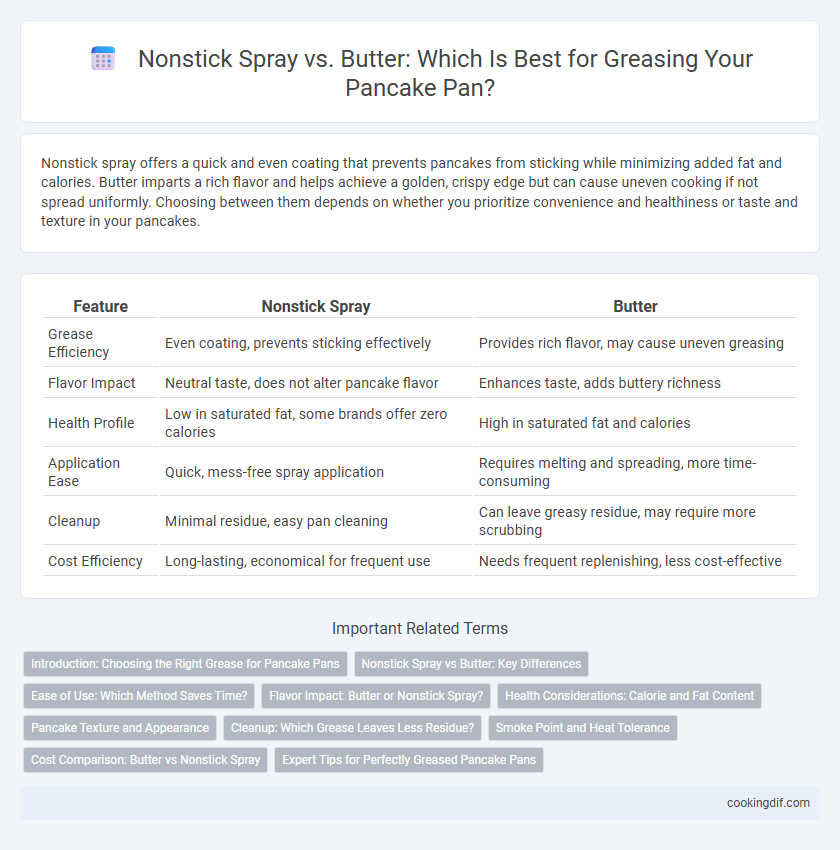Nonstick spray offers a quick and even coating that prevents pancakes from sticking while minimizing added fat and calories. Butter imparts a rich flavor and helps achieve a golden, crispy edge but can cause uneven cooking if not spread uniformly. Choosing between them depends on whether you prioritize convenience and healthiness or taste and texture in your pancakes.
Table of Comparison
| Feature | Nonstick Spray | Butter |
|---|---|---|
| Grease Efficiency | Even coating, prevents sticking effectively | Provides rich flavor, may cause uneven greasing |
| Flavor Impact | Neutral taste, does not alter pancake flavor | Enhances taste, adds buttery richness |
| Health Profile | Low in saturated fat, some brands offer zero calories | High in saturated fat and calories |
| Application Ease | Quick, mess-free spray application | Requires melting and spreading, more time-consuming |
| Cleanup | Minimal residue, easy pan cleaning | Can leave greasy residue, may require more scrubbing |
| Cost Efficiency | Long-lasting, economical for frequent use | Needs frequent replenishing, less cost-effective |
Introduction: Choosing the Right Grease for Pancake Pans
Nonstick spray offers a convenient, low-calorie option that evenly coats pancake pans to prevent sticking and promote consistent browning. Butter provides a rich flavor and helps achieve a golden, crispy edge but may burn at high temperatures. Selecting between nonstick spray and butter depends on the desired taste, texture, and cooking control preferences.
Nonstick Spray vs Butter: Key Differences
Nonstick spray provides a thin, even coating that prevents pancakes from sticking while minimizing added calories and fat, making it a healthier option compared to butter. Butter adds rich flavor and browning due to its milk solids but can lead to uneven grease distribution and higher fat content. Choosing nonstick spray or butter depends on the desired taste and health considerations when preparing pancakes.
Ease of Use: Which Method Saves Time?
Nonstick spray offers quick and even coverage, eliminating the need for cleanup of excess butter and reducing prep time, which is ideal for busy mornings. Butter requires melting and careful application to avoid uneven greasing or burning, often taking more time and attention. Choosing nonstick spray enhances efficiency in the kitchen while maintaining a smooth cooking surface for pancakes.
Flavor Impact: Butter or Nonstick Spray?
Butter imparts a rich, creamy flavor to pancakes, enhancing their overall taste with a slightly toasted, nutty aroma when melted in a pancake pan. Nonstick spray provides a neutral coating that prevents sticking without altering the flavor, allowing the pancake's natural taste to shine through. For a more indulgent and flavorful pancake experience, butter is often preferred, while nonstick spray is ideal for a lighter, less caloric option.
Health Considerations: Calorie and Fat Content
Nonstick spray typically contains fewer calories and less fat compared to butter, making it a healthier option for greasing a pancake pan. Butter adds saturated fat and significantly more calories, which can impact heart health and weight management. Choosing nonstick spray helps reduce overall calorie and fat intake while still preventing pancakes from sticking.
Pancake Texture and Appearance
Nonstick spray creates a consistent, thin coating that prevents sticking without altering the pancake's texture, resulting in a smooth, evenly browned surface. Butter adds a richer flavor and promotes browning, but may cause uneven spots and can create a slightly crispier edge due to uneven melting. For a uniform, tender pancake with a golden appearance, nonstick spray offers more control, while butter enhances flavor and visual appeal with its natural coloration and slight caramelization.
Cleanup: Which Grease Leaves Less Residue?
Nonstick spray leaves less residue compared to butter when greasing a pancake pan, resulting in easier cleanup and less buildup over time. Butter tends to caramelize and stick to the pan, making scrubbing more difficult and potentially causing uneven pancakes. For hassle-free cleanup, nonstick spray provides a more efficient and residue-free option.
Smoke Point and Heat Tolerance
Nonstick spray offers a higher smoke point and better heat tolerance compared to butter, reducing the risk of burning and smoke during pancake cooking. Butter, with a lower smoke point of around 350degF, can brown quickly and produce smoke, affecting the pancake flavor. Choosing nonstick spray enhances cooking efficiency and preserves the ideal pancake texture by preventing overheating and sticking.
Cost Comparison: Butter vs Nonstick Spray
Butter typically costs more per use compared to nonstick spray, as a small amount is required to thoroughly grease the pan, leading to higher overall expenses especially when cooking multiple batches of pancakes. Nonstick spray offers a cost-effective alternative, using minimal product per application and reducing waste, making it budget-friendly for frequent cooking. Considering pricing, nonstick spray provides a more economical solution for greasing pancake pans without compromising on performance.
Expert Tips for Perfectly Greased Pancake Pans
Nonstick spray provides an even, thin coating that prevents pancake batter from sticking and allows for easy flipping, making it a favorite among chefs for consistent results. Butter adds rich flavor and creates a slightly crisp edge but can burn quickly if the pan is too hot, so experts recommend melting it over low heat before spreading. For optimal greasing, use a light coat of nonstick spray combined with a small amount of butter for flavor and ideal browning.
Nonstick spray vs butter for greasing pancake pan Infographic

 cookingdif.com
cookingdif.com